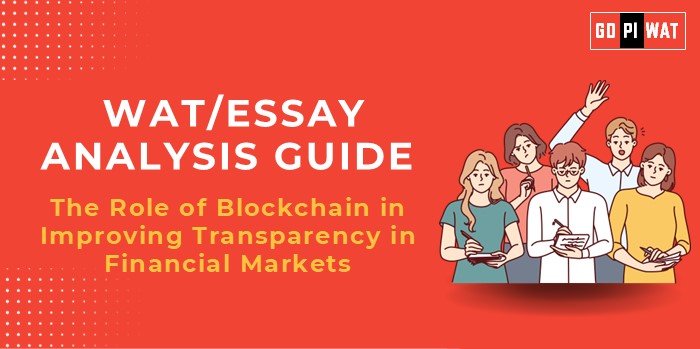📋 WAT/Essay Analysis Guide: The Role of Blockchain in Improving Transparency in Financial Markets
🌐 Understanding the Topic
Blockchain is pivotal in reshaping financial markets by introducing transparency, reducing fraud, and improving settlement efficiency.
📝 Effective Planning and Writing
- Time Allocation:
- ⏱️ Planning: 5 minutes
- ✍️ Writing: 20 minutes
- 🔄 Reviewing: 5 minutes
- Word Count Distribution:
- 📜 Introduction: 70 words
- ✍️ Body: 350 words
- 📄 Conclusion: 80 words
💡 Introduction Techniques for Essays
- Statistic-Based Approach: “By 2025, blockchain’s market value is expected to reach $39.7 billion, reflecting its growing role in transforming financial transparency.”
- Contrast Approach: “While traditional financial systems are plagued by fraud and inefficiencies, blockchain provides an innovative solution to address these issues.”
📊 Structuring the Essay Body
- 🏆 Achievements:
- ⚡ Near-instantaneous Settlements: Blockchain reduces systemic risks through faster transaction processing.
- 💰 Cost Savings: Significant savings in reconciliation and record-keeping processes.
- ⚠️ Challenges:
- 🌐 Lack of Global Regulations: Regulatory disparities hinder blockchain adoption in financial markets.
- ⚡ High Energy Consumption: Proof-of-work blockchains demand substantial computational resources.
- 🔮 Future Outlook:
- ♻️ Increased adoption of energy-efficient consensus models like proof-of-stake.
- 🤝 Collaboration between governments and private players to establish regulatory clarity.
📄 Concluding Effectively
- Balanced Perspective: “Blockchain holds immense promise for enhancing transparency in financial markets, but addressing its scalability and regulatory hurdles is essential for widespread adoption.”
- Global Comparison Approach: “While countries like Estonia lead in blockchain adoption, global collaboration is key to unlocking its full potential.”
🔍 Analyzing Successes and Shortcomings
- 🏅 Successes:
- ✔️ Enhanced trust through immutable records.
- 🔒 Reduction in fraud via transparent transaction ledgers.
- 💸 Cost efficiency in clearing and settlement operations.
- ⚠️ Challenges:
- 📏 Regulatory and technological barriers limiting global scalability.
- ⚡ High energy consumption associated with traditional blockchain systems.
🌱 Recommendations for Sustainable Progress
- 📜 Develop Regulatory Frameworks: Create global standards to ensure secure and consistent blockchain implementation.
- 🤝 Foster Public-Private Partnerships: Promote collaborations for scalable and effective blockchain solutions.
- ♻️ Adopt Energy-Efficient Models: Transition to consensus mechanisms like proof-of-stake to reduce environmental impact.
✍️ Sample Short Essays
- Balanced Perspective: “Blockchain offers unparalleled transparency in financial markets by reducing fraud and operational costs. However, regulatory uncertainty and scalability issues pose challenges that must be addressed for widespread adoption.”
- Solution-Oriented: “With blockchain, financial markets can achieve instant settlements and fraud-proof systems. Collaborative global regulations and energy-efficient models are essential for its sustainable success.”
- Global Comparison: “While blockchain is transforming financial markets globally, its adoption varies significantly. Countries like Estonia showcase its potential, but broader adoption requires addressing regulatory and scalability challenges.”


